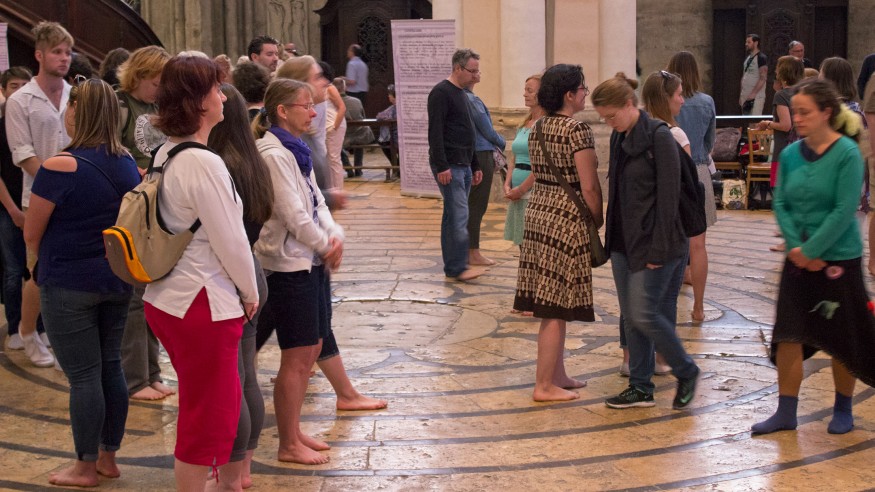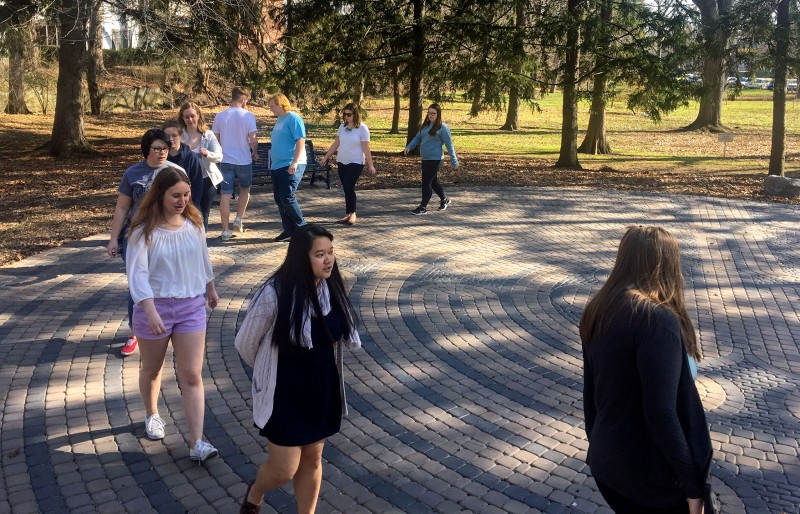
A Tale of Two Labyrinths
Students Visit French Inspiration for OWU's Labyrinth During Travel-Learning Course
Ohio Wesleyan University has two things in common with the Chartres Cathedral, located about 50 miles outside of Paris, France.
One, both sites have labyrinths – circular maze-like paths used for reflection and meditation. And two, Ohio Wesleyan students have explored both paths in their pursuit of knowledge.
Ellen Arnold, Ph.D., Ohio Wesleyan associate professor of history, was ecstatic when OWU’s labyrinth – a replica of the site at Chartres – was built in 2015. She saw an opportunity to teach students how medieval labyrinths were used as religious spaces for local pilgrimages in Christian Europe.
The learning experience at OWU’s labyrinth provided “resonance,” said Arnold, when her “Castles and Cathedrals in the Middle Ages” Travel-Learning Course traveled to Chartres to visit one of the world’s most famous and well-preserved labyrinths.
“Castles and Cathedrals” is part of The OWU Connection, a portfolio of beyond-the-classroom experiences that extend and enhance the University’s academic program. At the conclusion of Arnold’s semester-long course, students traveled throughout Germany and France for two weeks in May.
Elle Benak ’18, a history major on the trip, reflected, “Not only could you tell that some people traveled to Chartres specifically to walk the labyrinth, but you could also tell some were going there for an emotional and spiritual journey.”
Arnold said the intent of labyrinths in medieval Europe was “to provide a space for pilgrimage and for self-reflection within the confines of the local community instead of having to do pilgrimage all the way to Jerusalem or to the Holy Lands.”
“And so,” she continued, “what the labyrinth does is helps connect the act of physically walking and interacting with a space with the meditative qualities of prayer. It becomes a focal point of internal devotion.”
Kiersten Payne ’17, currently attending Yale Divinity School to pursue a Master of Arts in Religion, said visiting the Chartres labyrinth was special, for her, because of its spirituality.
“I had made a deliberate decision to finish the whole labyrinth and to be intentional about my thoughts the entire time,” Payne said. “Taking time to be deliberate about prayer or devotion, where there is a set beginning, a set path, and a set end, is certainly an effective process for religious practice.”
The Chartres labyrinth is one of the world’s oldest walkable labyrinths. To preserve the 800-year-old path, the labyrinth is covered for six days of the week, so modern tourism won’t wear it away.
Arnold, who took her class to visit when the labyrinth was open, chose to walk the path barefoot to feel the worn stone. “I wanted to feel the same thing all those hundreds of thousands of people had walked on.”

University Trustee Kathe Law Rhinesmith ’64, whose family gifted Ohio Wesleyan with the OWU labyrinth, has said she considers it to be a sacred space, nondenominational, and open to everyone.
“I’d like to believe it’s a place where each person who comes here will find something,” Rhinesmith said during its construction, “whether that be a casual and peaceful walk or a deeper moment of self-discovery and self-reflection.”
Arnold said the OWU labyrinth fulfilled that purpose for her students, and more.
“The opportunity to connect our experiences at OWU to those of pilgrims from around the world was exciting and humbling,” she said.
To learn more about The OWU Connection, including Travel-Learning Courses, visit www.owu.edu/owuconnection.
